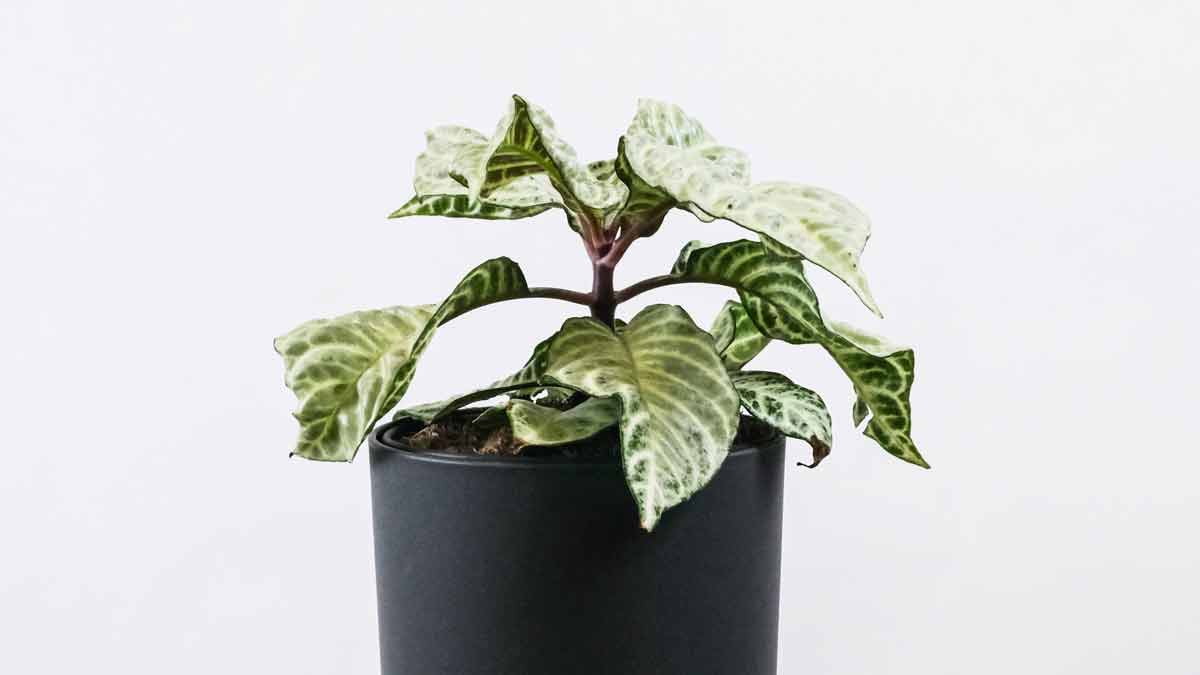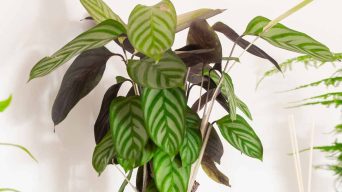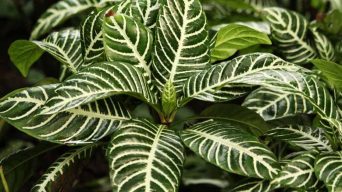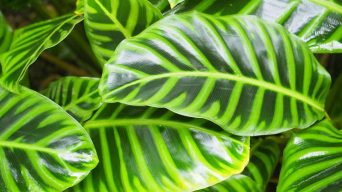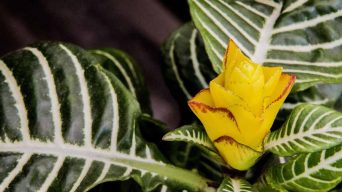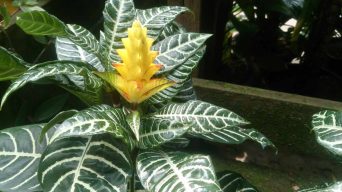The zebra plant (Aphelandra squarrosa) is a tropical evergreen shrub known for its distinctively veined, dark green leaves.
These beautiful plants can make lovely additions to any indoor space.
But what do you do when you notice your zebra plant leaves curling?
There are a few reasons why your zebra plant leaves might be curling.
It could be due to environmental factors, such as too much or too little water, or it could be a sign of a pest infestation.
It could also be a reaction to a change in temperature or light.
If you notice that your zebra plant leaves are curling, you can do a few things to try to fix the problem.
Read on to learn more about why your zebra plant leaves might be curling and what you can do about it.
Why Are My Zebra Plant Leaves Curling?
There are several reasons why your zebra plant leaves might be curling.
It’s essential to try to identify the cause so that you can take the appropriate steps to fix the problem.
The most common causes of curling leaves on zebra plants are:
1. Underwatering
One of the most common reasons for curling leaves on zebra plants is underwatering.
Zebra plants are native to tropical rainforests and are used to high humidity and lots of water.
The zebra plant leaves will start to droop and curl to conserve water if the plant is not getting enough moisture.
How To Tell If Your Zebra Plant Is Underwatered
A few signs will help you tell if your zebra plant is underwatered.
- The leaves will start to turn brown and papery
- The leaves will curl up or droop down
- The stems will start to shrink
- The plant will stop growing
How To Fix An Underwatered Zebra Plant
If you think your zebra plant is underwatered, the first thing you should do is check the soil.
Stick your finger into the soil up to the first knuckle.
If the soil is dry, it’s time to water your plant.
Water your zebra plant until the soil is evenly moistened and water drips out of the pot’s bottom.
Let the plant drain for a few minutes before putting it back in its spot.
Water your zebra plant once a week, or more often if the soil dries out faster than that.
2. Overwatering
While underwatering is a common problem, overwatering can cause curling leaves on zebra plants.
Zebra plants don’t like to sit in wet soil, so if you water too often or don’t let the plant drain properly after watering, the roots can start to rot.
This can cause the leaves to curl up and turn brown.
How To Tell If Your Zebra Plant Is Overwatered
A few signs will help you tell if your zebra plant is overwatered.
- The leaves will start to turn yellow
- The leaves will fall off
- The stems will soften and turn brown
- The roots will start to rot
How To Fix An Overwatered Zebra Plant
If you think your zebra plant is overwatered, you should first check the soil.
Stick your finger into the soil up to the first knuckle.
If the soil is wet, it’s time to stop watering your plant.
Let the soil dry out until it’s slightly damp before watering again.
Water your zebra plant less often, and ensure the plant can drain appropriately after each watering.
You might also need to check the roots to see if they’ve started to rot.
If the roots are brown and mushy, you can try to save the plant by trimming away the affected roots and repotting it in fresh, dry soil.
Ensure the new pot has drainage holes so the plant doesn’t become overwatered again.
3. Pest Infestation
Another common cause of curling leaves on zebra plants is a pest infestation.
Zebra plants are particularly susceptible to mealybugs and spider mites.
These pests can cause the leaves to curl up and turn brown.
They can also lead to stunted growth, yellow leaves, and leaf drop.
How To Tell If Your Zebra Plant Has A Pest Infestation
A few signs will help you tell if your zebra plant has a pest infestation.
- The leaves will have brown or yellow spots
- The leaves will start to curl up or fall off
- You’ll see webbing on the plant
- You’ll see small, white bugs on the plant
How To Fix A Pest Infestation On Your Zebra Plant
If you think your zebra plant has a pest infestation, you should first isolate the plant from any other plants.
Then, inspect the plant carefully for any signs of pests.
If you see any bugs on the plant, you can try to remove them with a cotton swab dipped in rubbing alcohol.
You can also use a natural insecticide, such as neem oil.
Be sure to follow the instructions on the label.
You might need to treat your plant several times before the pests are gone.
4. Too Much Sunlight
While zebra plants need some sunlight to thrive, too much sun can cause the leaves to curl up and turn brown.
Zebra plants exposed to direct sunlight for too long can get sunburned.
This will cause the leaves to turn brown and curl up at the edges.
How To Tell If Your Zebra Plant Is Getting Too Much Sunlight
A few signs will help you tell if your zebra plant is getting too much sunlight.
- The leaves will start to curl up, especially at the tips
- The leaves will turn yellow or brown and may even fall off the plant
- The plant will stop growing and producing new leaves
How To Fix A Zebra Plant That Is Getting Too Much Sunlight
If you think your zebra plant is getting too much sunlight, the first thing you should do is move the plant to a shadier spot.
The best spot for a zebra plant is one that gets indirect sunlight.
An east- or west-facing window is a good option.
You can also try to filter the sunlight with a sheer curtain.
5. Heat Stress
Heat stress is another common reason why zebra plants’ leaves curl up.
Zebra plants are native to tropical areas and prefer warm temperatures.
However, they can’t tolerate extreme heat.
The leaves will curl up and turn brown if the temperature gets too high.
How To Tell If Your Zebra Plant Is Suffering From Heat Stress
A few signs will help you tell if your zebra plant is suffering from heat stress.
- The leaves will start to curl up and turn brown
- The stems will become weak and start to droop
- The flowers will stop blooming, and the plant will lose its color
How To Fix A Zebra Plant That Is Suffering From Heat Stress
If you think your zebra plant is suffering from heat stress, the first thing you should do is move the plant to a cooler spot.
An air-conditioned room or a north-facing window are good options.
You can also try to increase the humidity around the plant by setting it on a tray of pebbles and water or using a humidifier.
If the temperature is hot, you can also try misting the plant with water.
6. Nutrient Deficiency
A nutrient deficiency can also cause the leaves of a zebra plant to curl up.
Zebra plants need a balanced fertilizer that contains all the nutrients they need to thrive.
If the plant isn’t getting enough of one of these nutrients, it will start to show signs of stress.
The most common nutrient deficiencies in zebra plants are nitrogen, phosphorus, and potassium.
How To Tell If Your Zebra Plant Has A Nutrient Deficiency
A few signs will help you tell if your zebra plant has a nutrient deficiency.
- The leaves will turn yellow or brown and may even fall off the plant
- The plant will stop growing and producing new leaves
- The flowers will stop blooming
How To Fix A Zebra Plant That Has A Nutrient Deficiency
If you think your zebra plant has a nutrient deficiency, you should first fertilize the plant.
Be sure to use a fertilizer that is specifically designed for tropical plants.
Follow the instructions on the label and be sure not to overfertilize the plant.
You can also supplement the soil with compost or other organic matter.
7. Compacted Soil
Compacted soil can also cause the leaves of a zebra plant to curl up.
Zebra plants need loose, well-draining soil to thrive.
If the potting soil is too dense, it will prevent the roots from getting the needed oxygen and water.
This will cause the leaves to curl up and turn brown.
How To Tell If Your Zebra Plant Has Compacted Soil
A few signs will help you tell if your zebra plant has compacted soil.
- The leaves will start to curl
- The soil is dry and crumbly
- The roots grow on the surface of the soil
- The plant does not grow as quickly as it used to
How To Fix A Zebra Plant That Has Compacted Soil
If you think your zebra plant has compacted soil, the first thing you should do is repot the plant.
Be sure to use a pot that is large enough for the roots and has drainage holes.
Fill the pot with loose, well-draining soil and water the plant well.
8. Overfertilizing
Overfertilizing can also cause the leaves of a zebra plant to curl up.
Zebra plants need a balanced fertilizer that contains all the nutrients they need to thrive.
Using too much fertilizer can burn the roots and cause the leaves to curl up and turn brown.
How To Tell If You Are Overfertilizing Your Zebra Plant
A few signs will help you tell if you are overfertilizing your zebra plant.
- The leaves will start to curl up and turn brown
- The plant will stop growing and producing new leaves
- The flowers will stop blooming
- The roots will start to rot
How To Fix An Overfertilized Zebra Plant
If you think your zebra plant is overfertilized, you first should flush the soil with water.
To do this, place the plant in the sink and slowly run water through the soil until it runs out the bottom of the pot.
Be sure to discard the water that comes out of the pot.
Do not fertilize the plant for a few weeks; only use half of the recommended fertilizer.
9. Transplant Shock
Transplant shock can also cause the leaves of a zebra plant to curl up.
Zebra plants are sensitive to changes in their environment and will undergo a period of adjustment when transplanted.
The leaves may curl up and turn yellow or brown during this time.
How To Tell If Your Zebra Plant Is In Transplant Shock
A few signs will help you tell if your zebra plant is in transplant shock.
- The leaves will begin to turn yellow or brown and curl up at the edges
- The plant will stop growing
- The leaves may drop off
- The leaves may start to droop
How To Fix A Zebra Plant That Is In Transplant Shock
If you think your zebra plant is in transplant shock, the best thing you can do is give it time.
Transplant shock is not fatal; the plant will eventually adjust to its new environment.
In the meantime, be sure to water the plant regularly and do not fertilize it.
10. Root Rot
Root rot can also cause the leaves of a zebra plant to curl up.
Root rot is caused by too much water and can kill a zebra plant quickly.
The roots will turn brown and mushy, and the leaves will curl up and turn yellow or brown.
How To Tell If Your Zebra Plant Has Root Rot
A few signs will help you tell if your zebra plant has root rot.
- The leaves will begin to turn yellow or brown and curl up at the edges
- The roots will be brown and mushy
- The plant will stop growing
- The leaves may drop off
How To Fix A Zebra Plant With Root Rot
If you think your zebra plant has root rot, carefully removing the plant from its pot is the best course of action. Inspect the roots; if they are brown and mushy, you will need to trim away any affected roots.
Plant the zebra plant in a fresh, well-draining potting mix and water it sparingly until it recovers. Don’t forget to check the drainage of your pot too. Your plant will quickly become waterlogged and rot if it doesn’t have any drainage holes.
How To Prevent Zebra Plant Leaves From Curling
You can do a few things to prevent the leaves of your zebra plant from curling.
- Be sure to water the plant regularly and evenly. Allow the soil to dry out between watering.
- Fertilize the plant every two weeks during the growing season with a balanced fertilizer.
- Place the plant in an area where it will receive bright indirect light.
- Transplant the plant into a one-size larger pot every two years.
- Be sure to check your pot’s drainage and make sure it has drainage holes.
- Do not overfertilize the plant.
- Do not put the plant in direct sunlight.
- Be careful when transplanting the plant.
Final Thoughts
Zebra plant leaves curling can be caused by several issues, including too much or too little water, pests, and temperature stress.
If you notice your zebra plant’s leaves are curling, look closely to see if you can identify the problem.
Once you know what’s causing the issue, you can take steps to fix it.
With the proper care, your zebra plant will soon look healthy and lush again.

